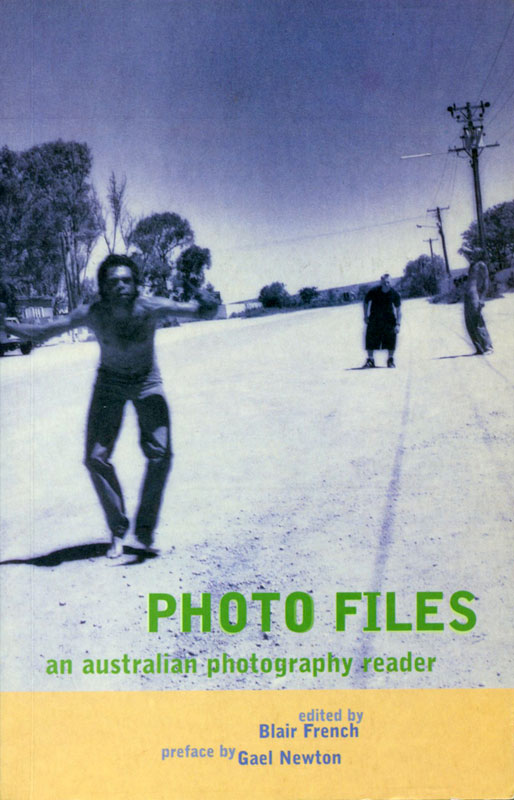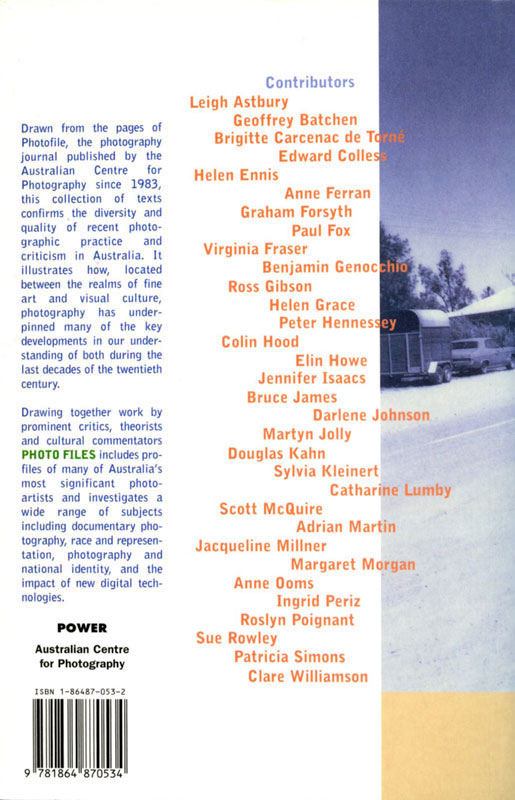Photo-Files
Preface for the above 2006 publication
Gael Newton AM
This essay was originally published as the Preface
for the 1999 Photo-Files - the australian photography reader 1999
see table of contents below this essay
 |
 |
| Power Publications and Australian Centre For Photography 1999 |
cover image: Tracey Moffatt, Up In The Sky #3 1997 (detail) |
The 1999 reader contains 33 essays selected by Blair French, who was then program manager for the Australian Centre for Photography (ACP). The texts had been previously published in the ACP's journal - Photofile - that had been published since 1983.
I wrote the preface to this publication. There's a table of contents below my essay along with links to information about photofile and the ACP.
Preface
In the 1970s, a decade before Photofile, the journal published by the Australian Centre for Photography (ACP) was launched in 1983, photography was claimed by the post-war generation as their medium in ways which the ubiquity of digital imaging and art photography today does not permit.
Carol Jerrems (1949-1980) was one of the most exemplary figures of the early years. In 1975 when she was 25, she adopted both a proprietary and moralising tone in regard to the role of photography when commenting on her work for one of the ACP's first publications: "My main interest in photographic art, as in living, is giving (learning and sharing). This society is sick and I must help change it."1
It is hard to imagine any young contemporary photographer talking quite like that now.
Had she lived Carol would have been 50 this year. Because of her premature death she is not present in Photofile to any great extent – although a self-portrait with the film-maker Esben Storm graced the cover of Photofile's 50th issue in 1997.
One of the ironies of the past decades is that Photofile has provided continuity in a field in which book publication on Australian photography has been erratic and disappointing. Currently there is a dearth of books in print on the most obvious topics. Huge amounts of work need to be done in standard publishing of historical and contemporary research of a sustained nature.2
With this publication of a group of essays from Photofile the journal is celebrating a coming-of-age. In its various guises it is an impressive production sustained and evolved over the years by much energy and elan.
The appearance of Photofile throughout the 1990s has been of ever increasing sensual appeal, as reproduction quality has improved along with increased use of colour. There have been some unforgettable covers, such as Brenda L. Croft's photograph on the 100% Mabo issue (40: 1994), Julie Rrap's swathe of folded skin on a cover designed by Suzanne Boccalatte (45: 1995) and the special South Pacific issue (Spring 1988) edited by Ross Gibson and designed by Sheona White and Peter Thorn.
The latter issue was a major effort and achievement, signalling important shifts in awareness of the region.
It is not to be forgotten that Photofile belongs to that perpetually endangered species; the art and literary ‘little magazine'. In this context its relationships to other ‘little magazines' is the subject of study and critique by literary historian Michael Denholm.
‘Little magazines' have a rich history. In photography there are the heavy-weight productions such as the seminal Camera Work from the early part of this century, but also a host of others which have been far more than picture magazines.
It is often the peril of ‘little magazines' to seem in their time to reach a tiny audience and yet to become major sources for future study long after the editors have got a 'day job' to survive. It would be interesting to set Photofile against some others of this ilk produced outside mainstream Europe and American photo-publishing.
Photofile was initially a newspaper format for reasons of economy but also probably inspired by the influential Afterimage published by the Visual Studies Workshop in Rochester, USA. Afterimage is still going strong and has resisted the temptation to become a glossy.
Photofile is something to be proud of both in its evolving design and production and as the brace of essays shows in the sophistication of the artists and writers included.
Early art and culture magazines in Australia such as Vision and Angry Penguins spent much of their editorial energy concerned with the threat of overseas influence. This provincialism has rarely appeared in Photofile which conducts itself in a reasonably relaxed state of being closely allied to trends overseas but not obsessed with positioning.
By launching in the early years of postmodernism Photofile was soon energised by the artists emerging in that decade. This has meant a pluralism and critical sophistication appropriate to the times but often alienating to an older generation.
Photography was often couched in the 1970s in what was really a version of the old light for photography as a fine art but which by contrast with pictorialist arguments and publications at the turn of the century defined itself by promotion of a type of vernacular naturalism deemed so unique as to have no relations with other contemporary art mediums.
The aesthetics of documentary and personal black and white photography managed to define an art that was not arty. Another obvious shift in a quick rear-view glance across the issues is that back in the early 1980s the role Aboriginal and Torres Strait Islander photographers would play was unimagined and yet emerges as one of the great indicators within the pages of later issues.
The 'place' of photography is largely an irrelevant issue for most Photofile readers. Speaking as an historian for a moment I would caution that the art world has proved very resistant to accommodating the idea, at least in historical studies, that a photographer can be central to a movement rather than peripheral.
This will change because there is also a parallel generation of art historians (cultural critics or whatever label you choose) who will write the future reflective accounts of the artists and issues of today. Lobbying, definition and redefinition is still, however, a role for both Photofile and the ACP.
Travelling round the world Photofile can be found in the specialist bookshops and centres. Its value in providing the only accessible source of information internationally on the state of photo-art in the antipodes is impossible to quantify.
If there was a prediction to make it would be that Photofile will emerge in the next decade more as a publication on photo-art in dialogue with other writers and artists from elsewhere internationally but most particularly within the Asia Pacific region
NOTES
- Carol Jerrems, artist statement, Graham Howe (ed.), New Photography Australia: A Selective Survey (Sydney: Australian Centre for Photography, 1974) 56
- Jerrems's work, at least will be the subject of a forthcoming monograph by Kelly Gellatly, at the National Gallery of Australia (Canberra)
Contents
Acknowledgments |
i |
Preface
Gael Newton |
iii |
Introduction
Blair French |
1 |
| |
|
1. CLAIMS ON THE DOCUMENT |
|
Signs of Ambivalence: Documentary Images
Scott McQuire |
17 |
Painted Photographs
Helen Ennis |
29 |
Between the Acts: Rebecca Cummins
Brigitte Carcenac de Torne |
39 |
Helen Grace: Secret Archives of the Recent Past
Margaret Morgan |
47 |
Photography Beside Itself
Benjamin Genocchio |
51 |
| |
|
| 2. HISTORY AND THE CONSTRUCTED IMAGE |
|
Reading a Thief's Journal
Ingrid Periz |
59 |
Immortal Stories
Adrian Martin |
67 |
Anne Zahalka: Resemblance and Displacement
Patricia Simons |
81 |
The Colonization of Time—X: Debra Phillips at Artspace
Graham Forsyth |
91 |
Reviewing the Archive: Alan Cruickshank
Catherine Lumby |
99 |
| |
|
3. DISTURBING IDENTITY |
|
The Swagman's After Image
Roslyn Poignant |
107 |
Girl Dancer at Rigo Festival
AnneOoms |
119 |
Mobilising the Margins
Sylvia Kleinert |
131 |
Dioramas: Classic Australian Photographs
Martyn Jolly |
139 |
Prima Facie: Unravelling Masculinity
Sue Rowley |
151 |
The Home and the World: Beyond the Politics of Difference
Jacqueline Millner |
157 |
| |
|
4. RACE AND REPRESENTATION |
|
The Imperial Schema: Ethnography, Photography and Collecting
Paul Fox |
169 |
Constructing the Other: Race and Representation
Leigh Astbury |
183 |
Aboriginality and the Politics of Representation
Darlene Johnson |
191 |
Images of Black and White: Jon Rhodes
Jennifer Isaacs |
199 |
Destiny's Dollys
Virginia Fraser |
207 |
Postcolonial Currents: The Work of Rea
Elin Howe |
215 |
Patterns of Connection: Leah King-Smith
Clare Williamson |
219 |
| |
|
5. TIME, SPACE AND TECHNOLOGY |
|
Post-Photography: After But Not Yet Beyond
Geoffrey Batchen |
227 |
Capital of Light: Robyn Stacey's Infinity Gardens
Colin Hood |
235 |
High Speed Nature: Rosemary Laing
Douglas Kahn |
239 |
Plastic Realist: Patricia Piccinini
Peter Hennessey |
247 |
| |
|
6. TESTIMONY |
|
Bill Henson and the Devil, Probably
Adrian Martin |
257 |
A Shroud of Evidence
Helen Grace |
261 |
Nowhere: David Stephenson
Edward Colless |
269 |
The Colour Clavecin: On Jacky Redgate
Ross Gibson |
281 |
Tracey in Timbuktu
Bruce James |
291 |
Photography's Still Living Body, Warm to the Touch
Anne Ferran |
299 |
| |
|
| Index |
307 |
| Notes on Contributors |
213 |
Links of Interest:
‘A Brief History of Photofile’, Photofile, No. 50, 1997 - Martyn Jolly 1997
Interview with Michael Fitzgerald about 30 yrs of Photofile
A History of the Australian Centre for Photography 1973-2013
The Australian Centre for Photography (ACP) was founded in 1973. In 1974 the ACP opened in its original premises in Paddington.
In 1981, with the assistance of the Sir William Dobell Foundation, the ACP moved into its own building on Oxford Street, Paddington.
The ACP journal, Photofile, began in 1983 and was a leading voice on contemporary photography.
After several years of 'changes', including the sale of its building on Oxford Street, on 20 November 2020 the ACP announced it was going into 'hiberantion'. Effectively this meant it ceased operations - till further notice.
For more on the ACP - click here
more of Gael Newton's Essays and Articles
|